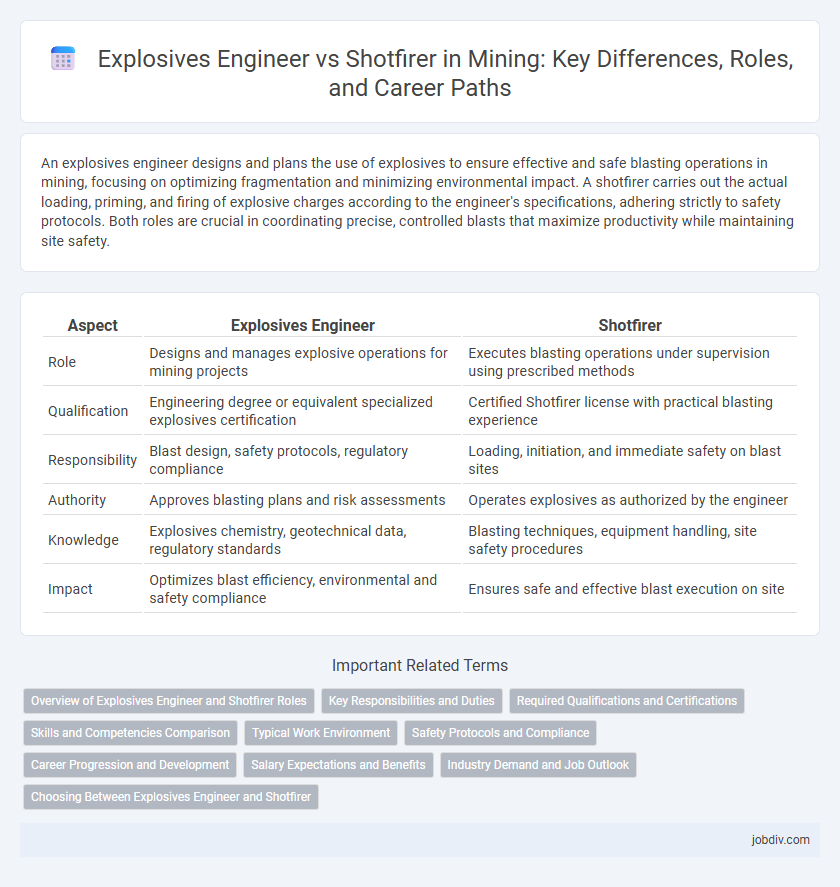An explosives engineer designs and plans the use of explosives to ensure effective and safe blasting operations in mining, focusing on optimizing fragmentation and minimizing environmental impact. A shotfirer carries out the actual loading, priming, and firing of explosive charges according to the engineer's specifications, adhering strictly to safety protocols. Both roles are crucial in coordinating precise, controlled blasts that maximize productivity while maintaining site safety.
Table of Comparison
| Aspect | Explosives Engineer | Shotfirer |
|---|---|---|
| Role | Designs and manages explosive operations for mining projects | Executes blasting operations under supervision using prescribed methods |
| Qualification | Engineering degree or equivalent specialized explosives certification | Certified Shotfirer license with practical blasting experience |
| Responsibility | Blast design, safety protocols, regulatory compliance | Loading, initiation, and immediate safety on blast sites |
| Authority | Approves blasting plans and risk assessments | Operates explosives as authorized by the engineer |
| Knowledge | Explosives chemistry, geotechnical data, regulatory standards | Blasting techniques, equipment handling, site safety procedures |
| Impact | Optimizes blast efficiency, environmental and safety compliance | Ensures safe and effective blast execution on site |
Overview of Explosives Engineer and Shotfirer Roles
Explosives Engineers design blasting plans and oversee the safe handling and use of explosives in mining operations to optimize fragmentation and ensure regulatory compliance. Shotfirers execute these plans by preparing, loading, and detonating explosives while maintaining strict safety protocols on-site. Both roles are critical for effective and secure blasting processes, with Engineers focusing on planning and analysis, and Shotfirers concentrating on operational implementation.
Key Responsibilities and Duties
Explosives Engineers design blast patterns, calculate explosive quantities, and ensure compliance with safety regulations by conducting risk assessments and environmental impact studies. Shotfirers execute blast plans by preparing surface or underground sites, loading explosives, and initiating controlled detonations while adhering to statutory safety protocols. Both roles require expertise in explosive materials, but Explosives Engineers focus on strategic planning and regulatory compliance, whereas Shotfirers are responsible for on-site handling and detonation operations.
Required Qualifications and Certifications
Explosives Engineers typically require a bachelor's degree in mining, chemical, or explosives engineering along with professional certification such as a Certified Explosives Engineer (CEE) credential. Shotfirers need certification through a recognized Shotfirer's Certificate or Blaster's License, often obtained via apprenticeship and regulatory examinations specific to the mining jurisdiction. Both roles demand comprehensive knowledge of explosive materials, safety protocols, and regulatory compliance, but Explosives Engineers focus more on design and risk assessment while Shotfirers emphasize practical initiation and blasting operations.
Skills and Competencies Comparison
Explosives Engineers possess advanced technical expertise in blast design, risk assessment, and regulatory compliance, enabling them to develop efficient and safe explosive plans for mining operations. Shotfirers specialize in the practical application of these plans, demonstrating proficiency in handling, transporting, and detonating explosives while following strict safety protocols. Both roles require strong knowledge of explosive materials and safety standards, but Engineers emphasize strategic planning and innovation, whereas Shotfirers focus on operational execution and real-time problem-solving.
Typical Work Environment
Explosives engineers in mining typically work in office settings for planning and design but also spend significant time on-site overseeing blasting operations and ensuring safety compliance. Shotfirers primarily operate directly at blast sites, handling the loading, initiation, and monitoring of explosives under strict regulatory frameworks. Both roles require adherence to safety protocols, but shotfirers experience more physically demanding and hazardous outdoor environments compared to the primarily supervisory and technical focus of explosives engineers.
Safety Protocols and Compliance
Explosives Engineers design and oversee blasting operations to maximize safety and efficiency, ensuring full compliance with mining regulations and industry standards. Shotfirers execute the detonation process on-site, strictly following safety protocols such as blast area clearance, timing sequences, and use of protective equipment to prevent accidents. Both roles require rigorous training, certification, and adherence to regulatory frameworks like MSHA or OSHA to mitigate risks associated with explosive materials.
Career Progression and Development
Explosives Engineers in mining typically undertake advanced technical responsibilities, including designing blast patterns and managing large-scale explosive operations, which positions them for leadership roles in project management and safety compliance. Shotfirers focus on the execution of blasting activities, gaining hands-on experience with explosive handling and regulatory adherence, often serving as a foundational step toward becoming a qualified engineer or site supervisor. Career progression in mining favors those who expand their expertise from shotfiring to explosives engineering, integrating qualifications such as a Diploma in Explosives Management or relevant certifications.
Salary Expectations and Benefits
Explosives Engineers in mining typically earn higher salaries, ranging from $90,000 to $130,000 annually, due to their advanced technical expertise and responsibility for blast design and safety compliance. Shotfirers generally have salaries between $60,000 and $85,000, reflecting their specialized role in executing blast operations under strict regulations. Benefits for both roles often include health insurance, retirement plans, and hazard pay, with Explosives Engineers sometimes receiving additional professional development opportunities and performance bonuses.
Industry Demand and Job Outlook
The mining industry shows increasing demand for explosives engineers due to their advanced expertise in designing blasting systems that maximize operational efficiency and safety. Shotfirers, who specialize in the execution of blasts and compliance with safety protocols, remain essential for on-site operations, though their demand is more stable rather than rapidly growing. Career prospects for explosives engineers are expanding, driven by technological advancements and regulatory requirements, while shotfirers face steady job opportunities aligned with ongoing mining projects.
Choosing Between Explosives Engineer and Shotfirer
Choosing between an explosives engineer and a shotfirer depends on the complexity and scale of the blasting operation in mining. Explosives engineers specialize in designing safe and efficient blast patterns, handling complex calculations, and ensuring regulatory compliance, while shotfirers focus on the practical execution of blast operations including loading and detonating charges. For projects requiring advanced technical expertise and risk management, an explosives engineer is essential, whereas shotfirers are suited for routine blasting tasks under their supervision.
Explosives Engineer vs Shotfirer Infographic

 jobdiv.com
jobdiv.com